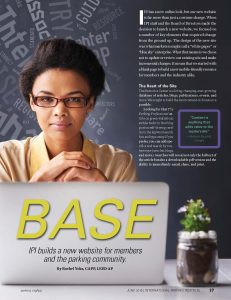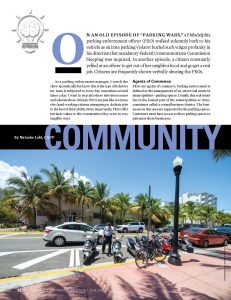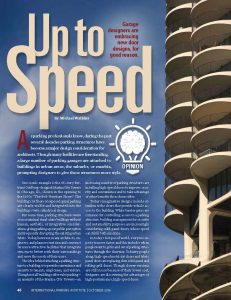IPI builds a new website for members and the parking community.
IPI has a new online look, but our new website is far more than just a costume change. When IPI staff and the Board of Directors made the decision to launch a new website, we focused on a number of key elements that required change from the ground up. The design of the new site was what marketers might call a “white paper” or “blue sky” enterprise. What that means is we chose not to update or review our existing site and make incremental changes. It means that we started with a blank page to build a new mobile-friendly resource for members and the industry alike.
The Heart of the Site
The Resource Center is a living, changing, ever-growing database of articles, blogs, publications, events, and more. We sought to build the most content-rich resource possible.
Looking for that The Parking Professional article on green walls from awhile back? Or that blog post on self-driving cars? Go to the keyword search box and type away. If you prefer, you can add specifics and search by content type (articles, blogs, and more). Searches will reveal not only the full text of the article but also a downloadable pdf version and the ability to immediately email, share, and print.
We did some of the searching in advance for you, as well. Categorized by major topics in our industry, you can select a topic and browse the most recent additions in the following areas:
- Certification Programs.
- Consumer Resources.
- Education & Training.
- Finance.
- Frontline.
- Management & Human Resources.
- Operations.
- Parking Matters®.
- Planning, Design, & Construction.
- Recognition & Awards.
- Regulatory Environment.
- Research.
- Safety & Security.
- State & Regional Associations.
- Sustainability.
- Technology.
- Transportation & Mobility.
Blog All About It
The Parking Matters® Blog launched in 2012 featuring the voices of our industry and publicizing the great work done by parking and transportation professionals worldwide. Utilized by media and parking pros alike, the blog platform provided members with the latest on the industry and the trends that will shape our shared future. This resource continues to do so on our new platform.
The blog is now embedded right in the IPI website and gets home page real estate in our front page feed. If you haven’t signed up yet, now is the time—look for daily posts throughout the week to keep you talking about the issues that matter. Same terrific and up-to-date information, with even greater visibility and frequency.
But wait, there’s more! Our members are the most active in the business—and we know you have a whole lot to say. IPI wants to hear directly from you so we made it as easy as we could. Membership has its privileges, as they say, and all members are encouraged to submit blog posts and join in the conversation. Blog posts should be 150 to 200 words on a relevant topic, event, or news story and can be easily submitted online. When you decide to blog with us, think short, sweet, and informative. We can’t wait to hear what you have to say.
To sign up and submit your blog post, check out any footer page of the website or go to parking.org/blog.
Your Personal Planner
If you are a planner, you know that everyone loves a good calendar. (And if you don’t have the planner gene and prefer to go with the flow, we’ve got you covered, too.) The calendar provides links and registration information for all IPI conferences, events, and trainings, as well as state and regional association events. These events include all scheduled educational opportunities, including webinars and face-to-face trainings. Plan ahead to make sure you make the most of your 2016 (and beyond)!
The Hallmark of IPI
Education and professional development is the hallmark of IPI. Our mission is to advance the parking profession, and the most critical component of that mission is to advance parking professionals themselves through numerous and varied educational opportunities to foster individual growth and development. It’s a lofty goal, and we are up to the challenge.
IPI provides a depth and breadth of training that is unmatched in the industry—and we know it’s a lot of information. One of our primary goals was to make sure members and colleagues have the many tools and resources at their fingertips (or their laptop, tablet, or smartphone). So we wanted to provide you with a brief outline of the very dense and resource-rich pages that talk about professional development.
Professional Development includes:
- Accredited Parking Organization (APO).
- Awards & Recognition.
- CAPP.
- Education & Training.
As you can imagine, each of these topics is chock-full of information, enough to fill many magazine editions and too much to print here. To give you a taste of the information available, here’s a sampling of what you will find when you go exploring Education & Training:
- Annual Conference. With more than 50 education sessions and informal learning opportunities, as well as face-to-face CAPP point classes, this is the most intense (and productive) week all year to amp up your expertise and knowledge.
- Online learning. Did you know IPI has invested in one of the best online learning programs on the market? From here, you can access multiple self-paced CAPP point and CEU offering courses for you and your team, especially those new to the industry. Selections include the following, with more on the horizon:
- Conflict Resolution.
- Customer Service.
- Foundations of Finance (NEW)
- Introduction to Parking.
- On-Street Parking Management.
- Parking Enforcement.
- Sustainability in Parking.
- Technology Trends in Parking.
- Onsite Courses. Choose to bring IPI training right to your office and elevate your entire team, or participate in regularly scheduled trainings, offered in a variety of locations. Courses include:
- Conflict Resolution.
- Customer Service.
- Media Training.
- Parking Design, Maintenance & Rehabilitation.
- Parking Enforcement.
- Tactical Communications.
- Green Garage (now Parksmart) Assessor Training.
There’s a lot to offer a parking pro (or newbie) here so we encourage you to discover the kind of education that is the best fit for you and your team.
Engage and Reap Big Rewards
IPI is a big community with big member benefits. Many of these are built right into parking.org. Members can pitch articles and submit blog posts, as well as share news releases about their companies and the industry.
Members and subscribers to The Parking Professional have immediate access to all issues and articles in a new format for online access. To see the latest, log in to your account and navigate to the magazine. Industry and member news feeds are right on the home page. If you would like to see your organization’s news front and center, visit parking.org/submitnews.
Do you have a request for proposal (RFP) or request for qualifications to publicize? Visit parking.org/rfp to post and get greater visibility for your upcoming project. Are you looking for the best talent in the industry? Navigate to parking.org/careerhq to post a position and find your next rising star.
Tips and Tricks
- Did you know that our Board of Directors has superpowers? Do you know who has the ability to do a cartwheel better than any other non-YPIP? Get to know your board (and our staff ) just a little bit better in the About section (at the very top of the site).
- Make parking.org a favorite on your browser of choice. Most sites perform best on Firefox and Chrome, and we recommend these browsers to get the most out of your browsing time.
- Subscribe to the IPInsider, our biweekly newsletter, and the blog. Delivered right to your inbox, this quick step will save you time and keep you up to date.
- Be your own content marketer and build your personal brand—when you see a post that made you smile or read an article that opened your eyes to a new trend, share it on Facebook, LinkedIn, or Twitter.
- Keep us posted, and share your feedback—this is your home page and your organization. We’ve received great comments and ideas so far, so please keep them coming!
RACHEL YOKA, CAPP, LEED AP, is IPI’s vice president for program development. She can be reached at yoka@parking.org.




